The Intel Broadwell Desktop Review: Core i7-5775C and Core i5-5675C Tested (Part 1)
by Ian Cutress on June 2, 2015 7:45 AM ESTProfessional Performance: Linux
Built around several freely available benchmarks for Linux, Linux-Bench is a project spearheaded by Patrick at ServeTheHome to streamline about a dozen of these tests in a single neat package run via a set of three commands using an Ubuntu 11.04 LiveCD. These tests include fluid dynamics used by NASA, ray-tracing, OpenSSL, molecular modeling, and a scalable data structure server for web deployments. We run Linux-Bench and have chosen to report a select few of the tests that rely on CPU and DRAM speed.
Due to our limited testing time and other issues, only the i7-5775C was processed in our Linux tests. These should be updated for Part 2.
C-Ray: link
C-Ray is a simple ray-tracing program that focuses almost exclusively on processor performance rather than DRAM access. The test in Linux-Bench renders a heavy complex scene offering a large scalable scenario.
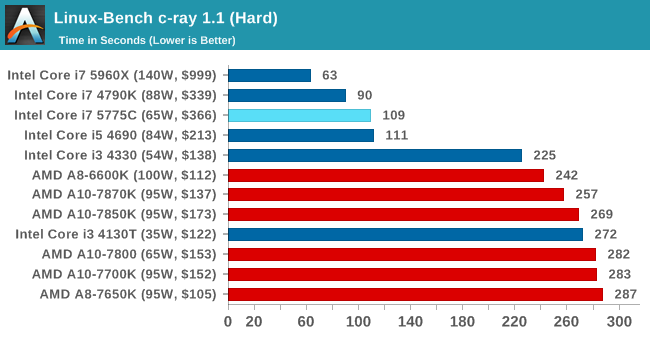
NAMD, Scalable Molecular Dynamics: link
Developed by the Theoretical and Computational Biophysics Group at the University of Illinois at Urbana-Champaign, NAMD is a set of parallel molecular dynamics codes for extreme parallelization up to and beyond 200,000 cores. The reference paper detailing NAMD has over 4000 citations, and our testing runs a small simulation where the calculation steps per unit time is the output vector.
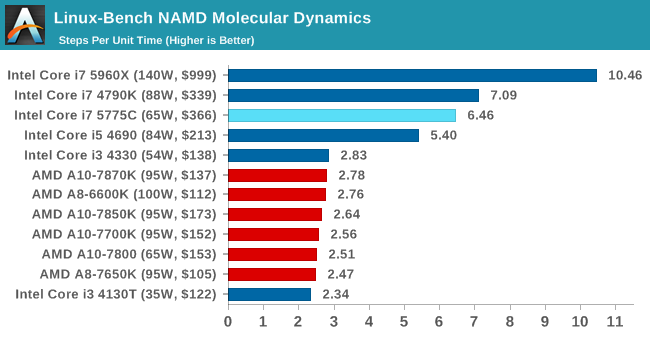
NPB, Fluid Dynamics: link
Aside from LINPACK, there are many other ways to benchmark supercomputers in terms of how effective they are for various types of mathematical processes. The NAS Parallel Benchmarks (NPB) are a set of small programs originally designed for NASA to test their supercomputers in terms of fluid dynamics simulations, useful for airflow reactions and design.
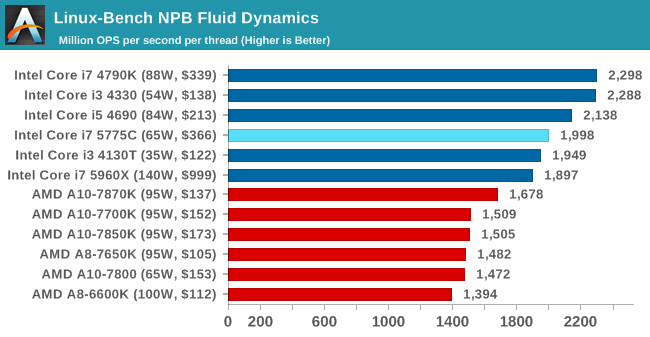
Redis: link
Many of the online applications rely on key-value caches and data structure servers to operate. Redis is an open-source, scalable web technology with a b developer base, but also relies heavily on memory bandwidth as well as CPU performance.
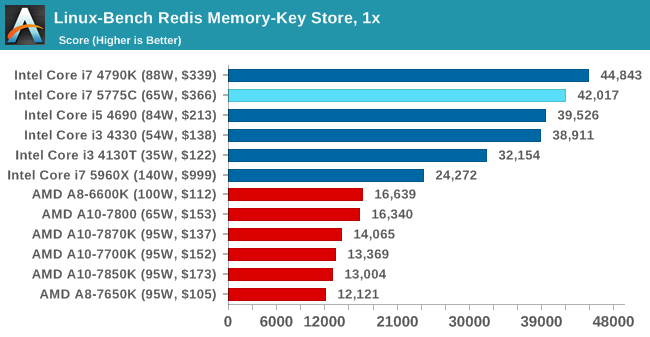
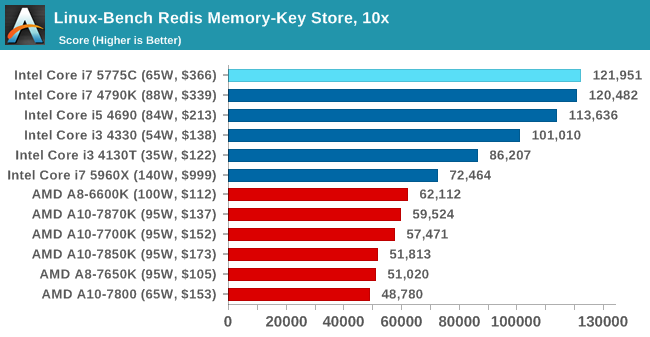
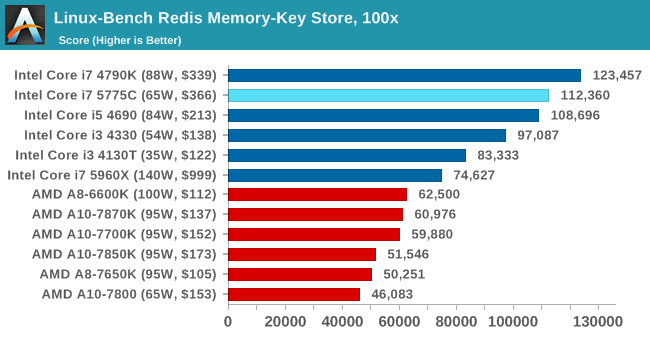










196 Comments
View All Comments
Flunk - Tuesday, June 2, 2015 - link
The 5820K is even available for < €400.ImSpartacus - Tuesday, June 2, 2015 - link
And it's not THAT expensive. It's certainly not cheap, but it's reasonable considering Intel's dominance.bug77 - Tuesday, June 2, 2015 - link
I would love to see a quad core clocked higher (or with better IPC). I don't use highly parallel software that much and I have no use for an integrated GPU.Sadly, with no competition, Intel has just been pumping the GPU for 4 generations in a row. Not that I blame them.
Taneli - Tuesday, June 2, 2015 - link
Improving single threaded performance is extremely hard, just ask AMD. I'd expect improvements of 5-10% per generation for the next few years.bug77 - Tuesday, June 2, 2015 - link
They could still raise the clock speed. Intel CPUs could hit 4GHz on air for years. Even the top-level Haswell can do it, but it's 4 core+HT part. If I could replace my i5-2500k with a 4GHz quad-core, that would be good enough for me. Removing the integrated GPU from the equation would yield even more thermal legroom for the CPU. But it's not happening. With CPU performance securely in their hands, Intel is trying to secure positions in GPU and mobile markets (they'd be crazy not to at least try to diversify).Yet raising the clock speed conflicts with higher IPC. Because raising clock speed needs a longer pipeline and a longer pipeline means taking a more serious hit for branch mispredictions. AMD has managed to seriously raise IPC with AthlonXP. Intel did it with their Core architecture. And nothing happened ever since. Because there's no more pressure on Intel and AMD doesn't have the cash to invest anymore.
swaaye - Tuesday, June 2, 2015 - link
You don't know that the GPU is impeding clock rate.Increases to clock rate increase power consumption dramatically. You can always overclock Broadwell yourself.
IPC has been steadily improving. Core 2, and anything from AMD, are far behind at this point.
bug77 - Tuesday, June 2, 2015 - link
"IPC has been steadily improving. Core 2, and anything from AMD, are far behind at this point."Not really. If you look here: http://www.anandtech.com/show/7003/the-haswell-rev...
You'll see there's usually less than 10% gained (watch the i7 3.5GHz parts). And that's spread over three generations. Broadwell bring another 2-3%.
And yes, AMD has been playing the same game, only they're stuck in their Athlon64 days.
MrSpadge - Tuesday, June 2, 2015 - link
Dude, Intel is offering exactly this with i7 4790K. A really highly clocked quad core. Use your external GPU and the iGPU won't consume any power nor limit clock speed. In fact it makes the die larger and thus helps cooling a bit.sonicmerlin - Tuesday, June 2, 2015 - link
Oh please. What a garbage excuse. "It's hard"? Intel's more than doubled IPC/Watt in their mobile chips over the last 3-4 years. They just don't care about high end IPC because they have no competition.vision33r - Tuesday, June 2, 2015 - link
That is what the XEON offers a better price and value than the X58xx line if you don't need unlocked performance. You can buy many XEON 6 cores cheaper than the X58xx line.